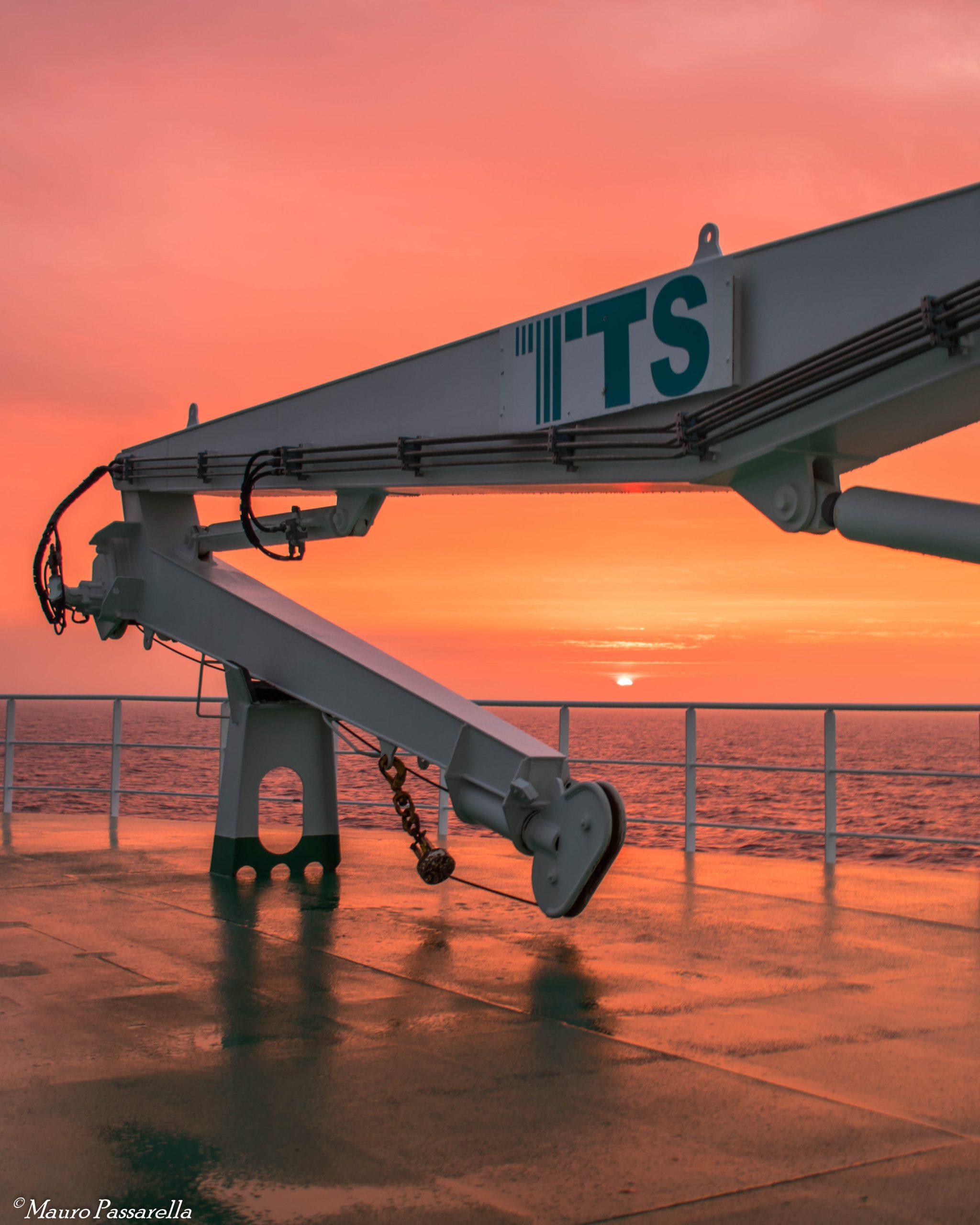
Normally, the time for participating to one of the scientific expeditions on board of a research vessel is between May and August, when the temperatures are not too cold, and you have light 24 hours in the Arctic Polar Circle. Beh…sure, it’s much better (for everyone on board) working with constant light, then constantly in the dark as it happens during the winter season. Don’t you agree?! However, the 10 days passed on board of my first scientific expedition without seeing the night, were pretty shocking! Your mind needs time to adapt to this condition. The schedule plan for research cruises is decided the year before for the new year coming. Each cruise can last from 2 to 5-6 weeks on the base of scientific studies and goals, as well as from the budget available. For this reason, the list of passengers needs to be discussed carefully. Therefore, depending on the place to be reached at sea, if in the presence of ice or not, the right vessel needs to be chosen! So, I’d say to start with a brief presentation of the two research vessels I had the opportunity to join during these initial months of my Postdoc: the RV Kronprins Haakon and the RV G.O.Sars (Fig. 1)…which they are real floating hotels!
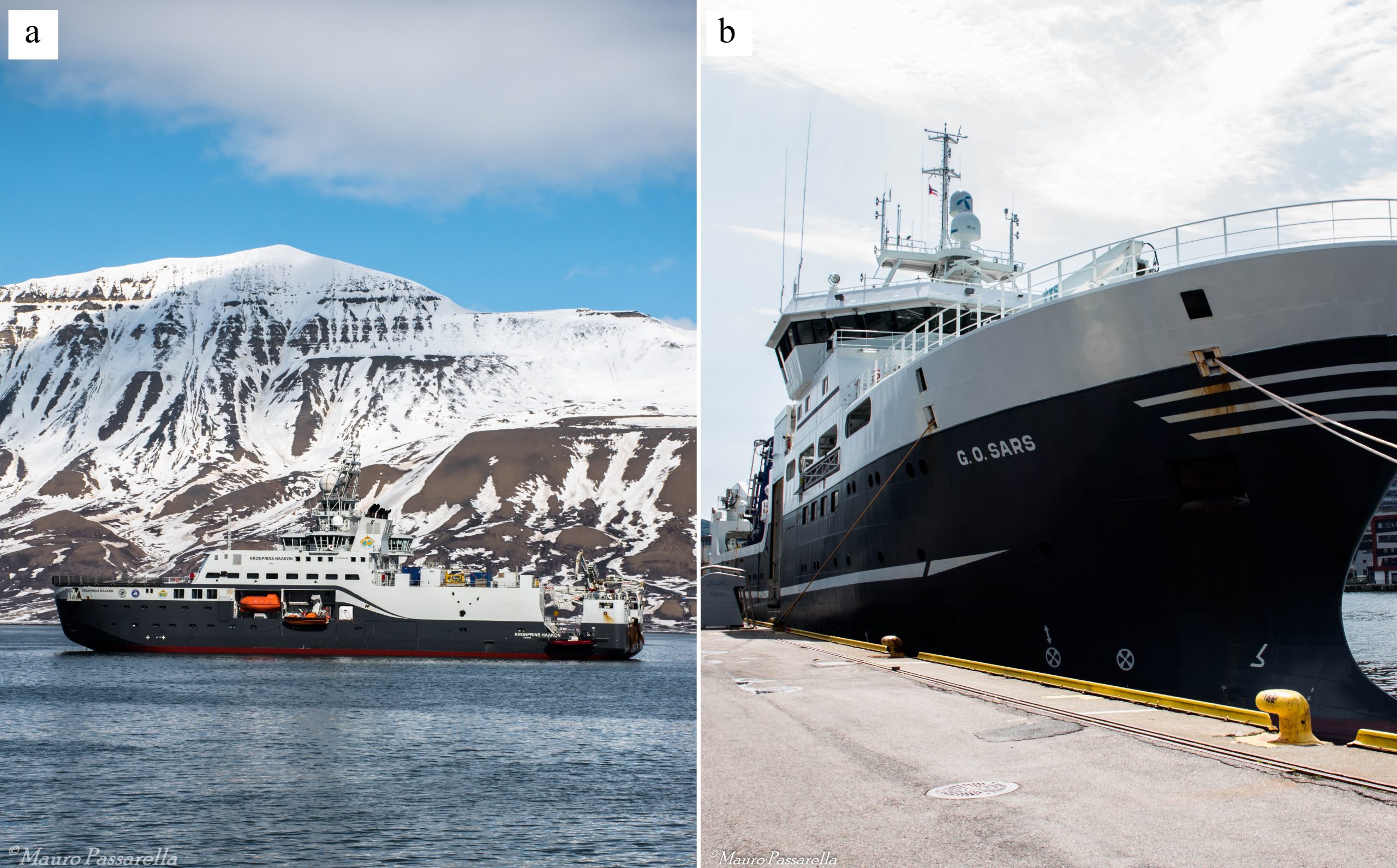
(© Mauro Passarella)
RV Kronprins Haakon
The research vessel Kronprins Haakon has been built to operate in challenging ice conditions. It’s an icebreaker, which means that it can go further north and south than any other Norwegian research vessel. It is equipped with the very latest high-tech equipment and has 15 laboratories, enabling the performance of complex studies directly on board. The boat has a cruising speed of 15 knots and is capable of breaking through ice up to one meter thick. The “Kronprins Haakon” represents a state-of-the-art for research vessels. It can accommodate up to 15-17 crew members and 35 scientists. The Norwegian Government decided to build this vessel in October 2012, and the Institute of Marine Research was put in charge of the project with a total budget of approximately 175 million euro. The vessel was designed by Rolls Royce Marine and built in Fincantieri shipyard in Genova (Italy), and finally delivered to Norway in 2018 [1].
RV G.O.Sars
The research vessel G.O.Sars was delivered in 2003 and is owned by the Institute of Marine Research (75%) and the University of Bergen (25%). It’s not an icebreaker. The main operating areas of the G.O.Sars are the Barents Sea, the Norwegian Sea, and the North Sea. The vessel has also carried out trips to the Mid Atlantic ridge and to the Antarctic. It’s a very quiet vessel (emits 99 percent less noise under water) compared to conventional research vessels. Thus, the researchers receive better quantity measurements during their analyses. It can accommodate 15 crew members and 30 scientists, and it has 15 laboratories [2].
Both vessels are equipped with several state-of-the-art instruments for all types of marine research able to observe and measure the water column between the seafloor and the surface. They are also equipped for taking core samples into the bottom sediments and conduct seismic surveys below the seabed up to 150 m using air gun sets. But especially, they can handle the first Norwegian Remotely Operated Vehicle (ROV), the Ægir6000, for rock and fluids sampling at seafloor (e.g., hydrothermal vents)… don’t worry, I’ll dedicate a separate post explaining ROV operations and other works during a scientific cruise :).
Cabin and First Approach On Board
Once on board the vessel, the own cabin key is delivered. For the research team, the cabin (Fig. 2) can be shared with someone (maximum two people – bunk bed) or if you are lucky, there could be a cabin just for you. This depends on the number of people on board, of course. Every cabin has a private bathroom with shower (this is nice), a desk, a spacious cabinet, and several electrical plugs. There is a satellite-TV connected with the informatic internal system which means that you can watch, directly from your cabin, at almost all data projected from the controls room on the ship: position (GPS), speed, several maps, as well as many normal TV channels (…we watched at the 2022 UEFA Champions League Final on May 28th between Liverpool and Real Madrid…). But especially, it is possible to follow the operations performed by the ROV Ægir6000 when it is operational during dives at seafloor! Room cleaning takes place every 2-3 days with linen change once a week. And don’t worry, you can sleep well without any light pollution in your room. Remember, Wi-Fi connection is not present in both vessels and there is not mobile phone signal when out at sea. But the Ethernet connection (and the cable!) is available in each cabin and in several rooms on the ship. However, it is possible to use an Ethernet LAN Network Adapter for Phone. Finally (and very important) you can use the washing machines available on board for cleaning your personal clothes when you need.
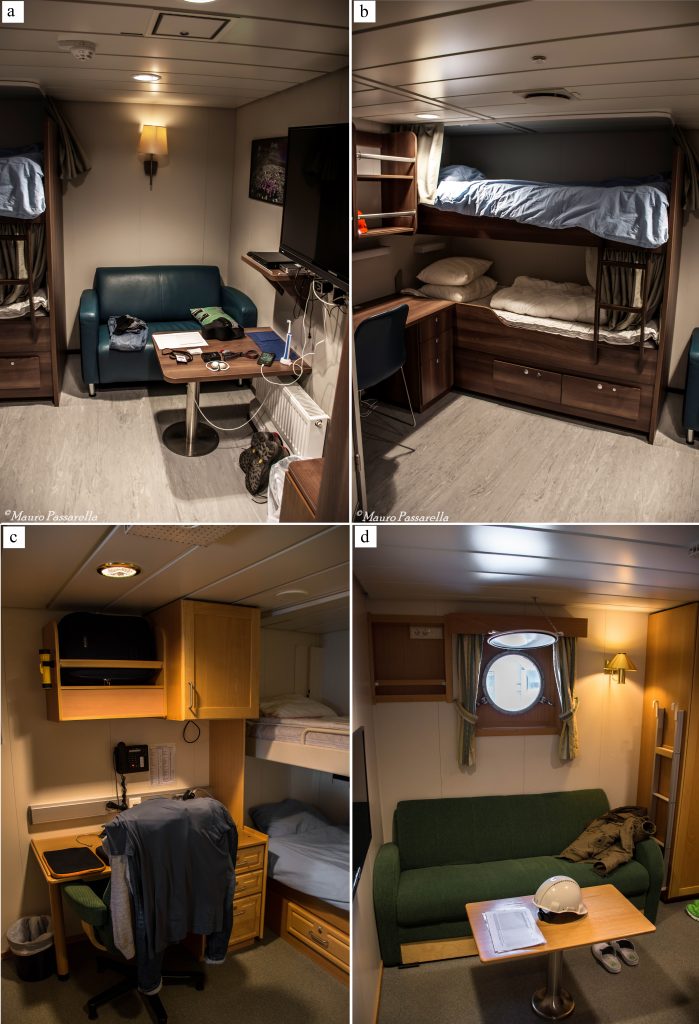
Fig. 2. Internal views of the cabins present in both the Kronprins Haakon (a,b) and the G.O.Sars (c,d) (© Mauro Passarella)
After having placed the luggage a first meeting between the team and a crew person is planned. The crew member gives all the main information about the vessel and the rules to follow. The presentation on screen is hold in one of the meeting rooms (Fig. 3) that are present on the ship. These rooms can be used for any work meeting by the members of the research team during the cruise. For example, we were used to be there at end of each working day (after dinner around 7:00pm) to discuss about the scientific results and making the new plan for the following day. At the end of the presentation, a quick and necessary demonstration of the procedure for the evacuation of the ship, is given. For example, wearing the evacuation suit is compulsory for everyone. Moreover, it can be also simulated a fire alarm situation, where ALL people on board must be at a predetermined location outside the vessel (so, be ready!). It is also possible to have a complete tour of the ship with the same crew member, if organized. I did it when I was on board of the G.O.Sars but not on board of the Kronprins Haakon. Also, the passports of everyone will be collected and returned to owners at the end of the cruise.
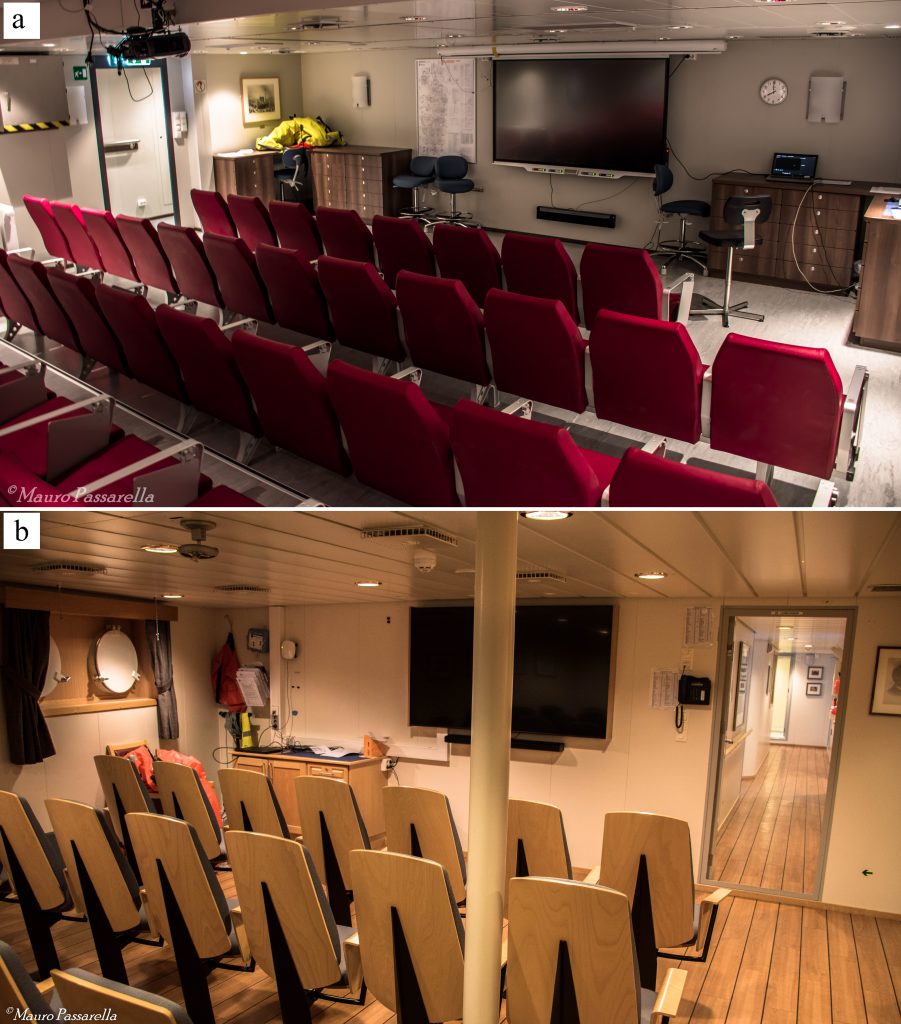
Working Time and Good Moves to Follow
Each individual of the research team has the own role on board of the vessel, which is determined before joining the cruise. Everyone works for the team. It’s a TEAMWORK. Depending on the goal to reach, the work can be split in different groups, or it can be done organizing 24-hours work shifts. Yes, sure, you can work during “day” or “night” hours. The important thing is that each member of the research team sleeps for at least 6-8 hours per day. It’s extremely important don’t overdo it because the fatigue would lead to a poor health condition which then reflects a negative impact on results of your research work. For this reason, a document on which to mark both own working and rest hours is delivered to everyone once on board, during the initial presentation. This document needs to be returned to the team leader at the end of the cruise. Some days you can work for many hours without interruption, and it can be very stressful. While other days you are less involved in the research. It’s very important to enjoy this moments by relaxing a bit. It’s fundamental don’t skip meals and eat regularly. This is especially important if you feel sick. Eating salty and going outside of the vessel for a walk, breathing fresh air while looking at the horizon, are all valid solutions for getting better. In other occasions, for example when the sea is pretty wavy and you feel really bad, the best thing to do it’s just lying on bed. This move helps a lot especially when you feel nausea. It’s important to follow these simple “measures” to be able to get back to work, quickly. In this regard, I really suggest bringing with you the sea sickness patches to put behind the ear. Each patch works for 72 hours and then you have to change it. They can be bought in pharmacy (medical prescription necessary), and they get your life much easier on board! Obviously, our job could not be carried out without the presence of the crew members: the commanders (whom are always two to cover 24 hours cruising), all the engineers, technicians, and kitchen stuff.
Meals and Relax
The main meals are three, every day: breakfast (at 7:30am), lunch (at 11:30am) and dinner (at 5:30pm), in the kitchen area (Fig. 4). Food is served by buffet, and people (in line) get what prefer. I was very impressed about the high quality of the kitchen. In both ships I found a wide-ranging menu, and very, very good food!! On the Kronprins Haakon the chef was from Sweden, while on the G.O.Sars the chef was from Norway. They were both great as well as all the waiters. Think about it, they all work to provide food and drinks ready for (more or less) 30 people, three times a day. This is admirable… And it doesn’t finish here, because the nicest part with food and beverage, is that in the kitchen area you always find something to eat and drink also outside the regular meals, 24 hours! (soooo nice…at least for me!).
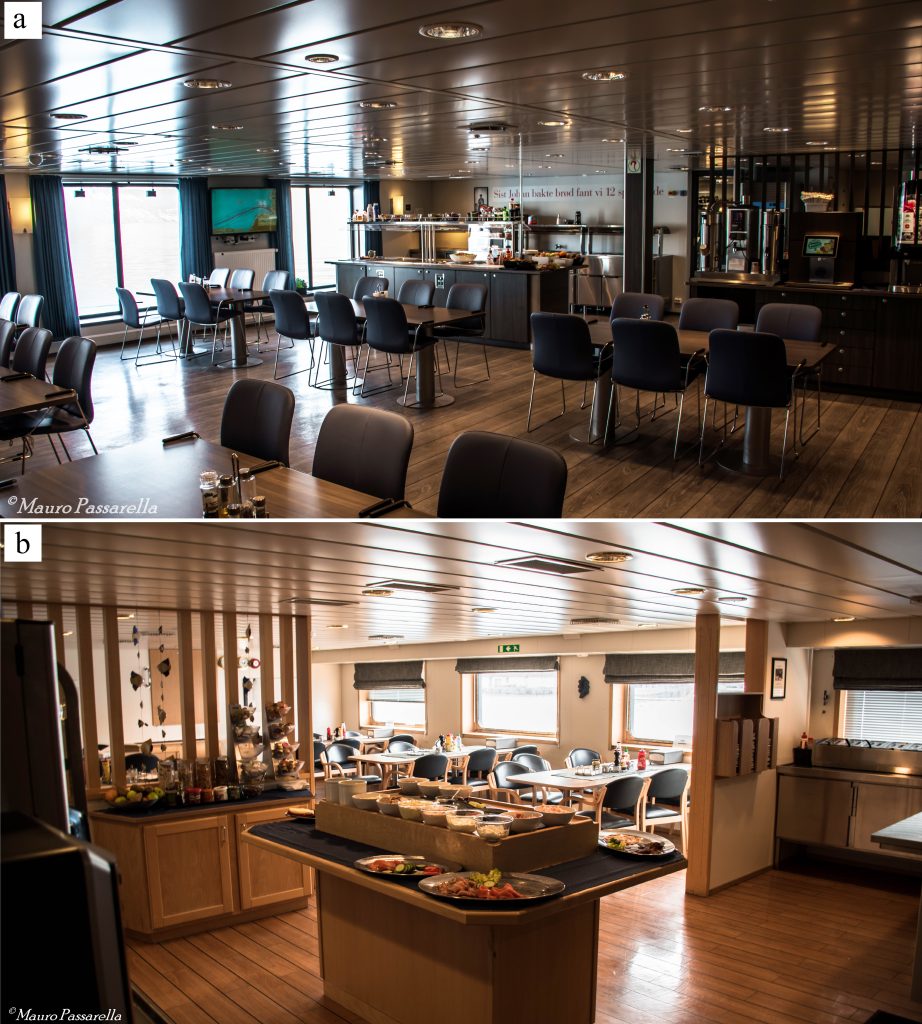
As I already mentioned before, the relax time is very important. Contrary to what you might think, there are many activities you can do during your relax time on board of a research vessel. And I was pretty shocked about it! For example, you can just sit down in one of the nice lounge areas (Fig. 5a-c) positioned in different levels of the ship, by reading, listening to music, or watching the TV. There is good list of movies to play 😊 in both vessels. Or you can just enjoy the landscape on deck outside the ship if it’s not raining and it’s not too windy. I suggest being there especially when the ship (the Kronprins Haakon) is breaking the frozen sea towards Greenland! (video 1, and Fig. 5d-l). Moreover, you might believe it or not but there is a gym room available in both vessels! (Fig. 5m-p). They are equipped with many different training machines. And finally (surprise) by each gym room you can find a…sauna. Yes, you read well! There is a sauna available 24 hours in both ships!!.
Video 1. Landscape outside the RV Kronprins Haakon during the research cruise at Molloy Deep (May 2022) (© Mauro Passarella)
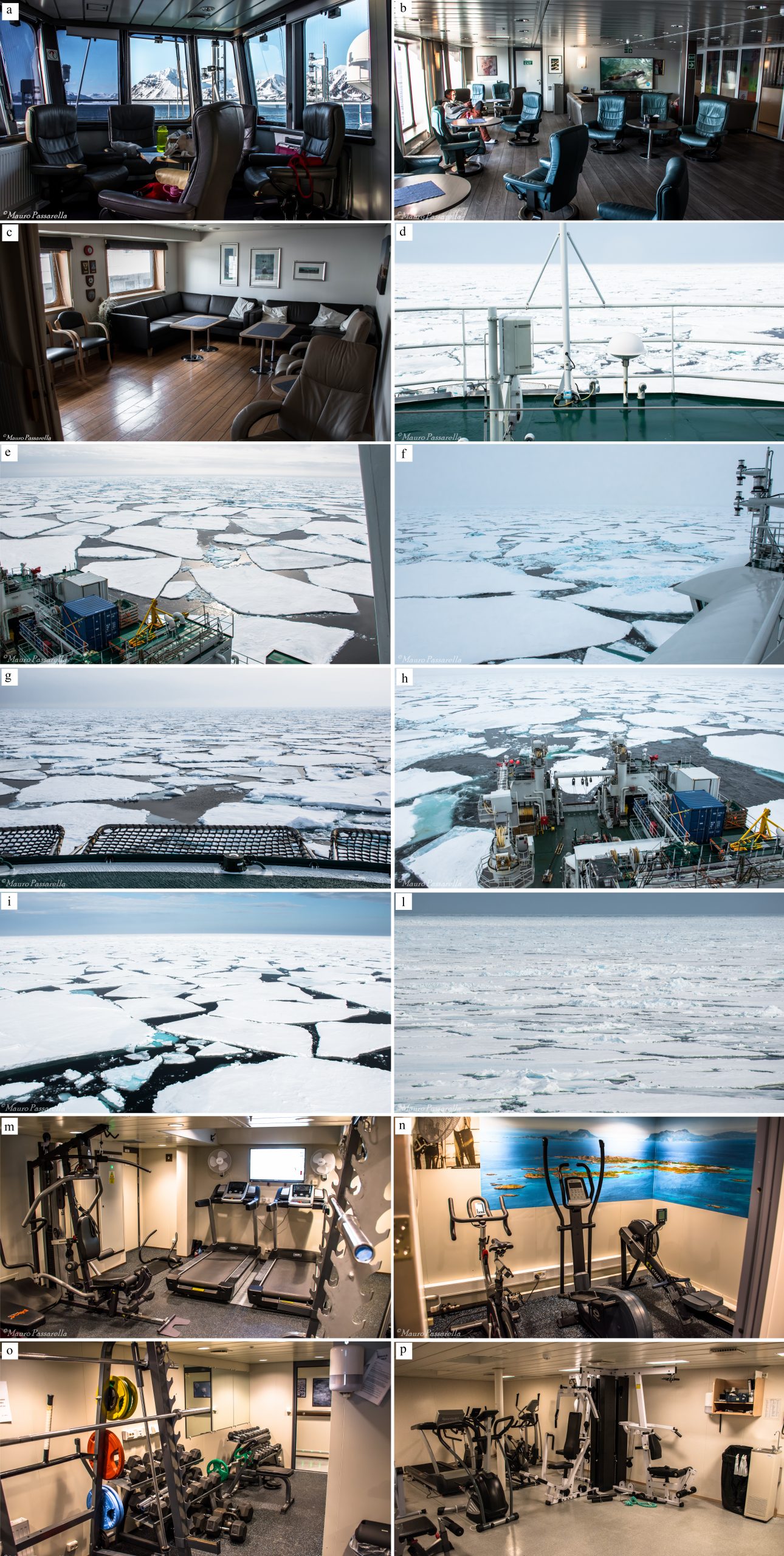
[1] https://www.hi.no/en/hi/about-us/facilities/our-vessels/kronprins-haakon
[2] https://www.hi.no/en/hi/about-us/facilities/our-vessels/g.o.-sars

Be First to Comment